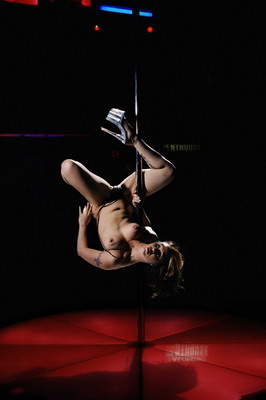Philip-Lorca diCorcia
dal 8/9/2005 al 8/10/2005
Segnalato da
8/9/2005
Philip-Lorca diCorcia
Pace Wildenstein, New York
Lucky Thirteen; new color photographs. The artist's pole dancers are suspended in time and space within the theatrically transfigured environments of strip clubs. A recognizable departure from the deliberate sequencing and elusive narrative characterizing his last body of work ('A Storybook Life,' 2003), 'Lucky Thirteen' is, at its essence, a series of psychologically penetrating portraits.

Lucky Thirteen
PaceWildenstein and Pace/MacGill are pleased to announce an exhibition of new color photographs by Philip-Lorca diCorcia on view in the Chelsea gallery from September 8 through October 8, 2005 (534 West 25th Street). Consisting of large-scale color prints (5 1/2 x 4 feet) featuring individual pole dancers, diCorcia’s “Lucky Thirteen†series was made in various locations in and around Los Angeles, Las Vegas and New York during 2003 and 2004.
The exhibition of “Lucky Thirteen†at PaceWildenstein and Pace/MacGill marks the series’ New York City premiere. The series debuted at the 2004 Carnegie International in Pittsburgh and selected pictures have also been exhibited in Cologne, London and Paris.
DiCorcia’s pole dancers are suspended in time and space within the theatrically transfigured environments of strip clubs. A recognizable departure from the deliberate sequencing and elusive narrative characterizing diCorcia’s last body of work (“A Storybook Life,†2003), “Lucky Thirteen†is, at its essence, a series of psychologically penetrating portraits. Referred to by their stage names--Harvest Moon, Lola, Pepper, Sin--the women in diCorcia’s photographs can be likened to sculpture insofar as they are simultaneously immortalized and monumentalized. The dancers’ bodies are rigid and their expressions appear as if frozen; diCorcia abstracts the dancers into a realm that is larger-than-life. Reviewing “Lucky Thirteen,†critic Morgan Falconer of Modern Painters observed:
Once again, light falls from the heavens in these pictures…it is remarkable how quickly one might find analogies for the pictures in the iconography of Christian martyrdom…one might also find more modern, secular analogies for the imagery in Constructivist sculptures… Comparing the subject matter to historical high art is, of course, only another way of bring redemption to it, and ultimately one must ask whether this is a good thing or not…. It is uncertain ground; diCorcia is brave to try and cross it, and he succeeds triumphantly.
At the beginning of his career in the late 1970s, diCorcia situated his friends and family within fictional interior tableaus. He later shifted his attention outward, photographing strangers in urban spaces--Berlin, Calcutta, Hollywood, New York, Rome, Tokyo--and infused the pictures with supplementary lighting to achieve a sense of heightened drama. Each of his series, “Hustlers,†“Streetwork,†“Heads,†“A Storybook Life,†and “Lucky Thirteen†can be considered progressive explorations of diCorcia’s formal and conceptual fields of interest.
Philip-Lorca diCorcia (b. 1951) studied at the School of the Museum of Fine Arts, Boston, and received his M.F.A. from Yale University. DiCorcia has received numerous awards and honors throughout his career including grants from the National Endowment for the Arts and the Guggenheim Foundation. In 2001, diCorcia won the Infinity Award for Applied Photography from the International Center of Photography. The artist received his first solo show in 1985 in Milan and, since joining Pace/MacGill in 1993, has been featured in one-person exhibitions worldwide. DiCorcia’s recent series “A Storybook Life†(2003) was exhibited at the Whitechapel Art Gallery, London, and traveled t the Centre National de la Photographie, Paris; the Museum Folkwang, Essen; Magazin 3, Stockholm Konsthall; Fondazione Bevilacqua La Masa, Venice; and the Centro de Artes Visuais, Coimbra.
Often acknowledged as one of the most influential photographers of his generation, diCorcia’s work is frequently shown alongside his peers in exhibitions intended to address our cultural zeitgeist. Exhibited in group shows throughout the United States and Europe since 1977, diCorcia's work was included in the traveling exhibition “Pleasures and Terrors of Domestic Comfort†organized by the Museum of Modern Art, New York (1991) prior to being given a solo show there (“Philip-Lorca diCorcia: Strangers,†1993). His work has been featured in the 1997 Biennial at the Whitney Museum of American Art, New York, and in “Cruel and Tender†organized by the Tate Modern and the Ludwig Museum (2003). Last year, diCorcia’s photographs were included in the exhibition “Fashioning Fiction in Photography Since 1990†at The Museum of Modern Art, New York.
DiCorcia’s work can be found in myriad public and private permanent art collections both here and abroad such as: the Chicago Museum of Contemporary Photography; the Los Angeles County Museum of Art; the Maison Européenne de la Photographie, Paris; the Metropolitan Museum of Art, New York; the Museo Nacional Centro de Art Reina Sofia, Madrid; the Museum of Fine Arts, Boston; the Museum of Fine Arts, Houston; The Museum of Modern Art, New York; the San Francisco Museum of Modern Art; the Solomon R. Guggenheim Museum, New York; and the Whitney Museum of American Art, New York.
Philip-Lorca diCorcia lives and works in New York City.
PaceWildenstein
32 E.57th St. 2nd floor - New York
Hours: Tues. -Fri. 9:30am-6pm, Sat. 10am-6pm



